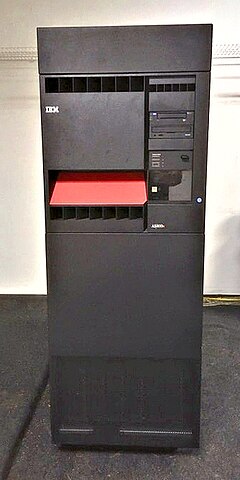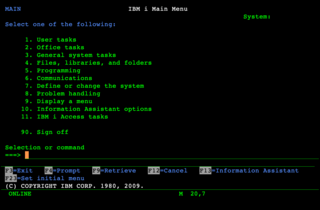Related Research Articles

A mainframe computer, informally called a mainframe or big iron, is a computer used primarily by large organizations for critical applications like bulk data processing for tasks such as censuses, industry and consumer statistics, enterprise resource planning, and large-scale transaction processing. A mainframe computer is large but not as large as a supercomputer and has more processing power than some other classes of computers, such as minicomputers, servers, workstations, and personal computers. Most large-scale computer-system architectures were established in the 1960s, but they continue to evolve. Mainframe computers are often used as servers.

A punched card is a piece of stiff paper that holds digital data represented by the presence or absence of holes in predefined positions. Punched cards were once common in data processing applications or to directly control automated machinery.

The IBM AS/400 is a family of midrange computers from IBM announced in June 1988. It was the intended successor to the System/36 and System/38 platforms, and ran the OS/400 operating system. Lower-cost but more powerful than its predecessors, the AS/400 series was extremely successful at launch, with one estimate stating 111,000 had been installed by the end of 1990 and annual revenue reaching $14 billion that year. Installs reached a peak of about 250,000 systems by 1994, by which time Unix-based systems had begun encroaching on the market.

Deep Blue was a chess-playing supercomputer developed by IBM. It was the first computer to win both a chess game and a chess match against a reigning world champion under regular time controls.

IBM PC compatible computers are similar to the original IBM PC, XT, and AT that are able to use the same software and expansion cards. Such computers were referred to as PC clones, or IBM clones. The term "IBM PC compatible" is now a historical description only, since IBM no longer sells personal computers. The designation "PC", as used in much of personal computer history has not meant "personal computer" generally, but rather an x86 computer capable of running the same software that a contemporary IBM PC could. The term was initially in contrast to the variety of home computer systems available in the early 1980s, such as the Apple II, TRS-80, and Commodore 64. Later, the term was primarily used in contrast to Apple's Macintosh computers.

A magnetic stripe card is a type of card capable of storing data by modifying the magnetism of tiny iron-based magnetic particles on a band of magnetic material on the card. The magnetic stripe, sometimes called swipe card or magstripe, is read by swiping past a magnetic reading head. Magnetic stripe cards are commonly used in credit cards, identity cards, and transportation tickets. They may also contain an RFID tag, a transponder device and/or a microchip mostly used for business premises access control or electronic payment.

A software release life cycle is the sum of the stages of development and maturity for a piece of computer software. Cycles range from its initial development to its eventual release, and include updated versions of the released version to help improve software or fix software bugs still present in the software.
The Rational Unified Process (RUP) is an iterative software development process framework created by the Rational Software Corporation, a division of IBM since 2003. RUP is not a single concrete prescriptive process, but rather an adaptable process framework, intended to be tailored by the development organizations and software project teams that will select the elements of the process that are appropriate for their needs. RUP is a specific implementation of the Unified Process.

IBM i is an operating system developed by IBM for IBM Power Systems. It was originally released in 1988 as OS/400, as the sole operating system of the IBM AS/400 line of systems. It was renamed to i5/OS in 2004, before being renamed a second time to IBM i in 2008. It is an evolution of the System/38 CPF operating system, with compatibility layers for System/36 SSP and AIX applications. It inherits a number of distinctive features from the System/38 platform, including the Machine Interface, the implementation of object-based addressing on top of a single-level store, and the tight integration of a relational database into the operating system.
Optical mark recognition is the process of reading information that people mark on surveys, tests and other paper documents..
Everett Franklin Lindquist was a professor of education at the University of Iowa College of Education. He is best known as the creator of the ACT and other standardized tests. His contributions to the field of educational testing are significant and still evident today.
Reynold B. Johnson was an American inventor and computer pioneer. A long-time employee of IBM, Johnson is said to be the "father" of the hard disk drive. Other inventions include automatic test scoring equipment and the videocassette tape.

Electrographic is a term used for punched-card and page-scanning technology that allowed cards or pages marked with a pencil to be processed or converted into punched cards. The primary developer of electrographic systems was IBM, who used mark sense as a trade name for both the forms and processing system. The term has since come to be used generically for any technology allowing marks made using ordinary writing implements to be processed, encompassing both optical mark recognition and electrographic technology.
The IBM 101 Electronic Statistical Machine, introduced in 1952, combines in one unit the functions of sorting, counting, accumulating, balancing, editing, and printing of summaries of facts recorded in IBM cards.
The IBM Type-III Library was software provided by IBM to its customers, available without charge, liability, or support, and typically in source-code format. The best known examples are for mainframe software, but IBM also used this same classification on smaller systems.
International Business Machines (IBM), nicknamed "Big Blue", is a multinational computer technology and IT consulting corporation headquartered in Armonk, New York, United States. IBM originated from the bringing together of several companies that worked to automate routine business transactions, including the first companies to build punched card based data tabulating machines and to build time clocks. In 1911, these companies were amalgamated into the Computing-Tabulating-Recording Company (CTR).
SIMMON was a proprietary software testing system developed in the late 1960s in the IBM Product Test Laboratory, then at Poughkeepsie, N.Y. It was designed for the then-new line of System/360 computers as a vehicle for testing the software that IBM was developing for that architecture. SIMMON was first described at the IBM SimSymp 1968 symposium, held at Rye, New York.
Cognos ReportNet (CRN) was a web-based software product for creating and managing ad hoc and custom-made reports. ReportNet was developed by the Ottawa-based company Cognos, an IBM company. The web-based reporting tool was launched in September 2003. Since IBM's acquisition of Cognos, ReportNet has been renamed IBM Cognos ReportNet like all other Cognos products.

Watson is a question-answering computer system capable of answering questions posed in natural language, developed in IBM's DeepQA project by a research team led by principal investigator David Ferrucci. Watson was named after IBM's founder and first CEO, industrialist Thomas J. Watson.

Linux on IBM Z is the collective term for the Linux operating system compiled to run on IBM mainframes, especially IBM Z and IBM LinuxONE servers. Similar terms which imply the same meaning are Linux on zEnterprise, Linux on zSeries, Linux/390, Linux/390x, etc. The three Linux distributions certified for usage on the IBM Z hardware platform are Red Hat Enterprise Linux, SUSE Linux Enterprise, and Ubuntu.
References
- "Bulletin of Information on the International Test Scoring Machine." (New York: Cooperative Test Service, 1936)
- IBM Archives web page on the 805 Test Scoring Machine
- ↑ "IBM100 - Automated Test Scoring". www-03.ibm.com. 2012-03-07. Retrieved 2021-11-27.